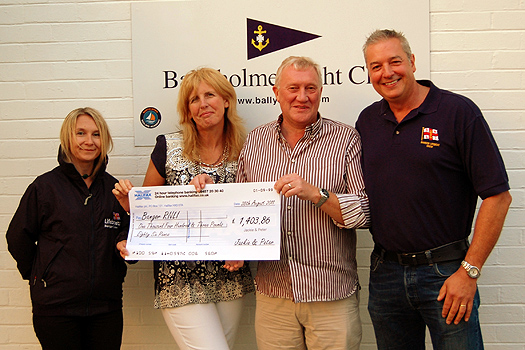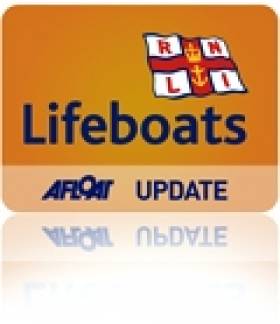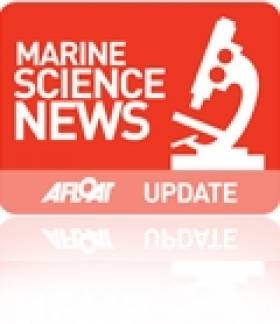Displaying items by tag: Gift
A Wedding Gift that Will Save Lives at Sea
Newly married couple Jackie and Peter Gracey have presented RNLI Bangor Branch with a cheque for £1403.86. Three weeks ago Mr and Mrs Gracey held a wedding party at the Ballholme Yacht Club and in lieu of wedding presents they had requested that a donation be made to Bangor RNLI.
The presentation was made during the RNLI Bangor Lifeboat BBQ held at Ballyholme Yacht Club.

Jackie and Peter (centre) present their cheque
During the evening crew members and guests raised over £1500.00 for the Royal National Lifeboat Institution Bangor Branch.
RNLI senior helmsman Kyle Marshall said 'We would like to thank everyone who attended the crew BBQ and helped raise this fantastic sum of money.' He added 'Special thanks must go to Jackie and Peter; their very special wedding gift will save lives at sea, on behalf of the crew at Bangor Station I would like to wish them a very happy future together.'
Lifeboat volunteer crew at Bangor have launched on service numerous times this year, in all weather conditions and on many occasions during the hours of darkness.
The majority of call outs have been to leisure craft including canoes, powerboat, yachts and speedboats. Difficulties have been caused in the most part by mechanical failure of one kind or another. The rescues have been diverse, taking RNLI's Bangor Lifeboat right across Belfast Lough to Black Head and up towards Belfast as far as the M3 bridge over the River Lagan. Rescues are not always confined to boats in distress. A number this year have been related to suspected attempted suicides and missing persons, others have been to people stranded on rocks caught by the rising tide.
Celtic Mist Needs Funds for Refit
The Irish Whale and Dolphin Group (IWDG) has published a notice for its plans to refit the yacht Celtic Mist as a research vessel.
As previously reported on Afloat.ie, Celtic Mist was gifted to the IWDG by the Haughey family to help the group in its marine wildlife conservation work.
Under its new ownership, it completed a leg of this year's Tall Ships Race and found a new home at a sponsored berth at Kilrush, Co Clare.
Currently the IWDG is applying to the Clare Local Development Company for LEADER funding towards the refit.
IWDG co-ordinator Dr Simon Berrow said: "We are eligible for 75% funding but need to provide 25% funding ourselves. We estimate this to be in the region of €12,500.
"Celtic Mist has already cost IWDG around €5,000-7,500 so we must start a fundraising campaign to cover these and other costs."
Anyone who wishes to contribute to the fundraising campaign can contact the IWDG at [email protected]. All donations above €250 are tax deductable.
Celtic Mist Reaches Scotland, Ready for New Life
The yacht once owned by former Taoiseach Charles Haughey will return to Ireland next week for its new life as a marine research vessel after completing the first leg of the 2011 Tall Ships Races.
The 52-foot Celtic Mist, the only Irish entrant in this year's races, came "a respectable last in our class”, skipper Fiacc Ó Brolcháin told The Irish Times from Scotland.
As previously reported on Afloat.ie, the yacht will know be fitted out with scientific instruments after it was gifted by the Haughey family to the Irish Whale and Dolphin Group (IWDG) to support its conservation work.
Fastnet Ferry Figures Smash 2010 Target
The passenger figure represents four-times the capacity of the Liberty Stadium, Swansea which is to host the rugby Heineken Cup clash between Swansea Neath Ospreys and Munster on Saturday 18 December.
The 10-hour ferry service operated by Fastnet Line also carried 31,000 vehicles and statistics suggest a significant boost for the Swansea Bay economy with about 40% of all passengers so far travelling from Cork to the south Wales region. The route is served by the MV Julia which had been sailing in the Baltic. The 1982 built vessel is capable of carrying more than 1,800 passengers and 400 cars.
Fastnet Line will run all-year-round in 2011 and has set a revised target of 120,000 passengers.
On a seasonal note, Christmas gift vouchers are available from Fastnet Line, for more information logon HERE
































































